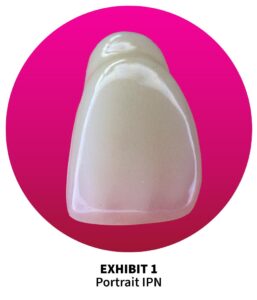 Why Esthetics Matter in Digital Denture Teeth
Why Esthetics Matter in Digital Denture Teeth
Choosing the right teeth for dentures isn’t just about durability. Digital denture teeth esthetics play a crucial role in patient satisfaction and treatment outcomes. As the dental industry shifts toward fully digital workflows, understanding the esthetic elements of denture teeth becomes increasingly important.
One of the most important attributes of any denture is the appearance of the teeth. In the American market, certain esthetic norms have emerged over time. Among all teeth, the maxillary central incisors are considered the most visually significant — whether natural or artificial. Manufacturers typically mold denture tooth shade guides from a maxillary central incisor.
In Exhibit 1, you’ll see a maxillary central from the premanufactured Portrait IPN line — mold 22E in shade A2. Although esthetics are always somewhat subjective, North American preferences tend to focus on five core features. All of these are present in the Portrait IPN tooth.
-
Translucent incisal edge: The incisal edge must be translucent. Ideally, this translucency should wrap around the mesial and distal corners and extend into the interproximal spaces.
-
Mamelons: Sometimes called “lobes,” mamelons should be subtly visible. These downward-protruding structures add natural irregularity and depth.
-
Neck contrast: The neck of the tooth should appear darker — in color science, this means a lower value.
-
Surface translucency: A translucent labial-buccal surface allows light to pass through to underlying layers, enhancing depth.
-
Labial surface contour: For central anteriors, the labial surface must have a slight undulation. This shape helps reflect light naturally, like ripples on a pond.
Now let’s look at teeth esthetics in a variety of digital dentures. I have established four categories so you can more clearly understand the differences (Exhibit 2).
Exhibit 2

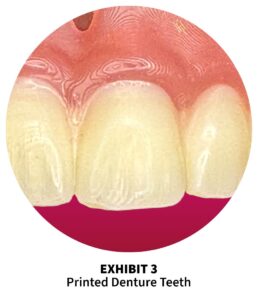 1. 3D-Printed DLP Denture Teeth
1. 3D-Printed DLP Denture Teeth
The first category is 3D-printed teeth using digital light processing (DLP) — the most common 3D printing method. 3D printers use a single material to produce these teeth.. Manufacturers attempt to balance opacity and translucency, aiming for a translucent incisal edge and a more opaque body.
Most resins can achieve that horizontal translucency. However, they fail to produce the natural look that comes from translucency wrapping around the mesial and distal corners. Because manufacturers form the teeth from a uniform material, mamelons do not exist. While some techniques attempt to simulate them by carving vertical grooves into the labial surface, the effect is minimal and not convincing.
3D-printed teeth also lack a distinct neck contrast since there is no shading variation in the material. Sometimes, the denture base gives the illusion of a darker neck, but that effect remains inconsistent and less effective than with high-end esthetic denture teeth.
Surface translucency in these teeth comes from the base material itself. Without a second contrasting layer, however, the result is a flat, monochromatic look with little depth. The labial surface quality depends heavily on how it’s finished. Even if the digital file includes natural contours, aggressive polishing during finishing can flatten the anatomy. Because 3D printing occurs in layers, this process often results in a surface that resemble a topographical map unless refinished carefully — as shown in Exhibit 3.
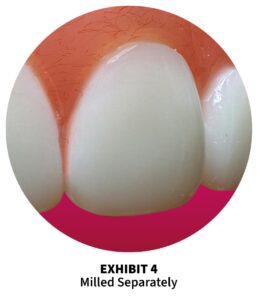 2. Milled Single-Layer Denture Teeth
2. Milled Single-Layer Denture Teeth
The second category is milled single-layer teeth, where the teeth and base are milled separately and then bonded. Milling produces dimensionally accurate results, but in terms of esthetics, the approach has pros and cons.
Translucency depends on the properties of the single-layer PMMA puck. Like 3D printing, achieving an esthetic balance requires manufacturers to compromise between incisal translucency and body opacity. And like 3D-printed teeth, this translucency remains horizontal only, with no extension into the mesial or distal corners.
In terms of mamelons, neck contrast, and surface translucency, milled single-layer teeth perform no better than their printed counterparts. However, the labial surface quality tends to be slightly better. The smoother raw finish requires less manual adjustment. Still, it doesn’t match the finish of injection-molded denture teeth formed in steel molds.
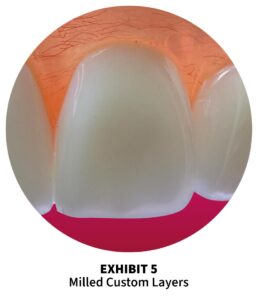 3. Milled Multi-Layer Denture Teeth
3. Milled Multi-Layer Denture Teeth
In this third category, technicians mill the teeth from a multi-layered puck made of 8 to 16 stacked layers. These layers transition from translucent to opaque horizontally, similar to sliced cheese. This design improves incisal edge appearance slightly compared to single-layer pucks.
By positioning anterior teeth precisely within the puck, technicians can optimize where the translucent layers fall. However, translucency still does not curve up into the corners or interproximal areas. Laterals, being slightly raised from centrals, may not align optimally with the puck’s translucent zone.
Mamelons are still absent in this technique. However, neck contrast improves due to the puck's darker lower layers. Despite this, the effect is again limited to a horizontal gradient. Like the prior categories, surface translucency lacks true depth and appears flat.
4. AvaDent Milled Custom-Layer Denture Teeth
AvaDent’s milled custom-layer teeth make up the final category, which take a monolithic approach — digitally layering custom dentin and enamel for each individual tooth. This method addresses nearly all the limitations of the other three.
Technicians mill the dentin layer with natural-looking mamelons first. They then apply a translucent enamel layer over the top, covering the entire labial-buccal surface. The result is a level of incisal translucency that rivals premium denture teeth.
AvaDent’s AI-driven software automatically adjusts mamelon geometry based on tooth size, ensuring visual consistency across molds. Translucency wraps around the mesial and distal edges, just like in the best premanufactured teeth.
The neck contrast comes from the base material visible through the translucent enamel. While not as dramatic as that seen in the Portrait IPN tooth — which uses a specific darker neck layer — it still delivers esthetically pleasing results.
Surface translucency and the labial finish are where this approach truly shines. Unlike printed or single-puck milled teeth, AvaDent’s surface is already layered for depth and light reflection. Although technicians must polish the surface to remove milling marks, the final result closely mimics premium, carded denture teeth.
Final Grades and Esthetic Summary
As summarized in Exhibit 6, each category presents tradeoffs. But AvaDent’s milled custom-layer approach earns the highest marks for digital denture teeth esthetics — closely matching the visual qualities of Portrait IPN pre-manufactured teeth.
Choosing the Best Esthetic Denture Teeth
Selecting denture teeth goes beyond durability or manufacturing method. Digital denture teeth esthetics can profoundly affect patient satisfaction. Studies show that patients are far more likely to accept dentures that mimic natural teeth in detail and translucency.
To learn how AvaDent’s innovations enhance esthetics and clinical outcomes, visit us at AvaDent.com.
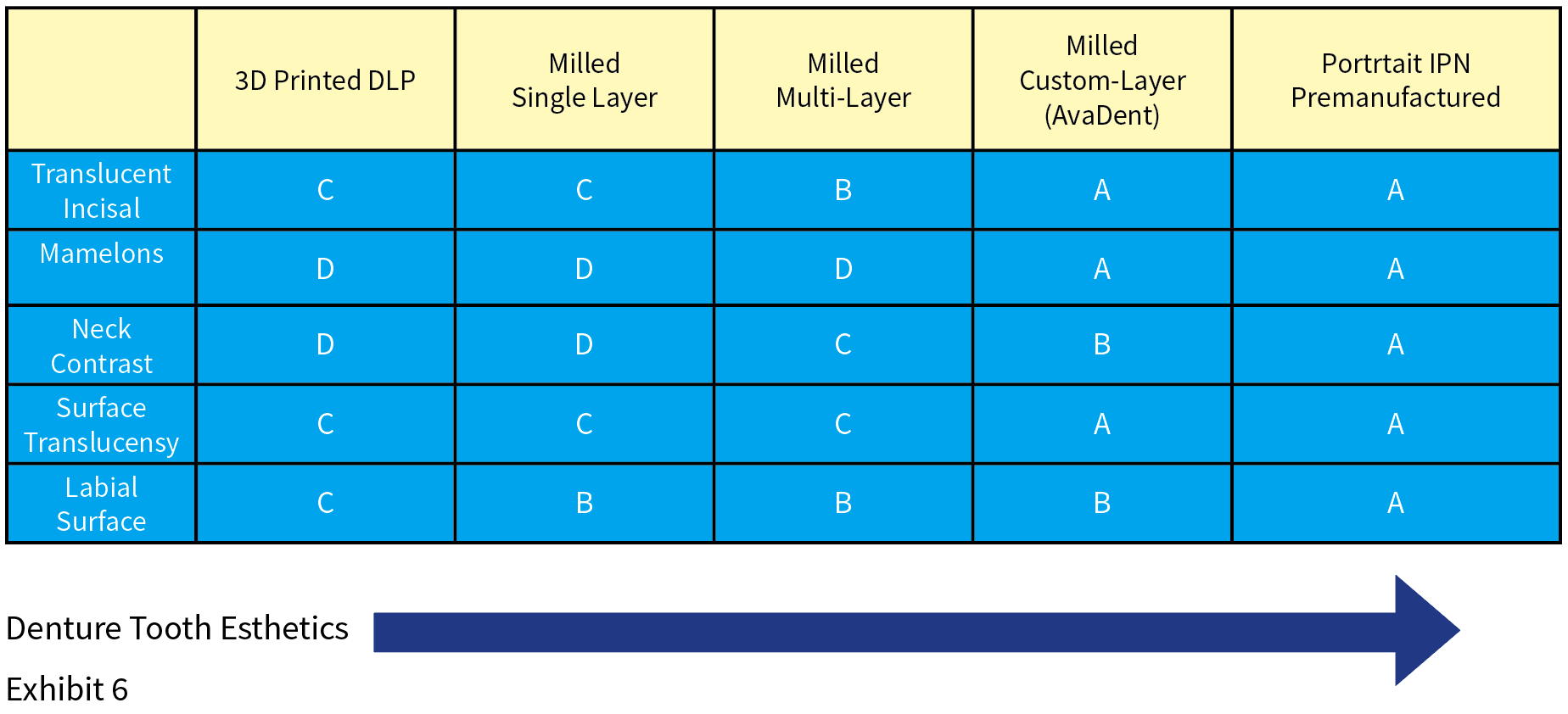
All images were taken with an iPhone14 macro lens. Digital denture teeth esthetics




